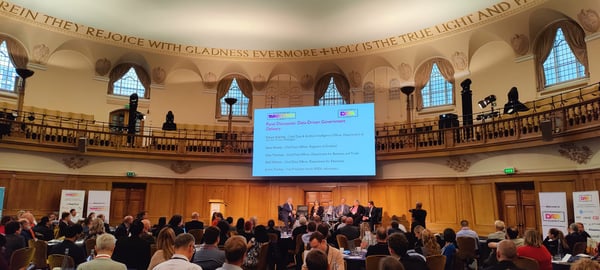Exploring the future of government delivery
The recent Government Transformation Summit brought together over 400
digital, data and technology leaders with public sector experts from the UK,
Canada, Estonia, Ukraine and Poland. The sessions and discussion around the
event highlighted some of the challenges (and opportunities) that government delivery faces.
The Valtech team hosted a discussion table on the topic of evidence-based decision-making. Delegates joined us to share their experience and explore the possibilities and challenges of improving policy using different kinds of data.
We also participated in the Challenge Lab, where small groups focused on specific challenges brought to the table by government representatives. We’ve summarised some of the main themes and discussions raised during
the day.
Expectations, capabilities and pressures
The opening session highlighted the pivot point that government digital is at. Rich Corbridge from DWP, Joanna Rowland from HMRC and Vidya ShankarNarayan of Agri Food Canada explored the tension between increasing citizen expectations, new technical capabilities and the pressure of public sector operations.
During the keynotes, panel and breakout sessions that followed, there was plenty of debate about the best way forward. Data and AI were central to much of the discussion, but research, decision-making and culture were also hot topics.
How do we use data to inform power decision-making in practice?
Data is already informing design choices and decisions in digital services development, and vast amounts of data are available in most areas of government. Delegates considered how the data behind a decision could and should be used to inform decisions and, as importantly, decision-makers.
Attendees agreed that decisions should be more data-driven. However, they felt that finding, navigating and interpreting data isn’t always straightforward. Not only that but analysing and distilling it into compelling insights that convince and persuade is a real art.
Some thought that we needed to look beyond adding skills, feeling that the whole culture around decision-making must evolve. They highlighted the need to build shared ideas, customs and behaviours around data.
Initiatives such as BOLD (Better Outcomes through Linked Data) are helping to demonstrate the value of data, especially using it in combination with data from other departments or services. BOLD is working with the Department of Levelling-Up, Communities and Housing and the Ministry of Justice to track the passage of citizens through the justice system to build a digital twin that can help model and assess the impact of interventions.
What steps can we take to productise and validate data sets?
There was support for the need to continue unlocking the data held across government. If we can create and promote more exemplars that demonstrate the potential, people believe that we could accelerate the process of change and encourage services to document the source, scope and quality of data sets.
The Central Digital and Data Office (CDDO) explained how they have developed a data maturity assessment model that should help everyone understand the provenance and validity of a data set. Focused on assessing ownership, version control, use cases (and limitations or misuse cases), quality assurance processes and maintenance frameworks, we welcome this type of initiative to support data productisation. It’s a crucial step in making data sets more discoverable and, ultimately, more widely used.
Are decisions actually working?
Data science has great potential to support large-scale government services. However, some participants stressed the importance of defining success and capturing sufficient data, pre-and post-delivery, to enable teams to measure the impact. Some delegates felt that if we can’t – or don’t – do this, we limit our ability to gauge whether policy decisions deliver the policy intent at the citizen or user level.
It seems that the data captured before a service is delivered or upgraded is often inadequate. Consequently, it can be hard to baseline the ‘before’ situation and almost impossible to measure the impact of the change. Perhaps the CDDO framework can be a benchmark for upgrading existing service data.
Can AI be made accountable?
One aspect of AI that has received limited attention, certainly in the context of government services, is its potential to make explaining or justifying decisions more problematic. As more use is made of machine learning and generative AI, careful thought must be given to capturing the reasons for a decision.
If AI evolves its decision-making based on patterns, similarities, or other factors, explaining the decisions to citizens will be challenging. What if, over time, a service changes its decision in a specific scenario based on its learning?
This thought led to a discussion about what we think citizens want from government services. Do they want them to be entirely logical and predictable, or do they value the automation and productivity that AI and increased use of data might deliver?
The Government Transformation Summit was a hugely thought-provoking day that was enriched by different perspectives and experiences. I very much enjoyed meeting and speaking to people so fully engaged in getting better outcomes for government and citizens. The healthy exchange of ideas really served the aim of joining things up.





